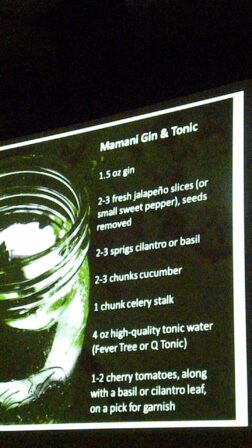Botany and Booze
In January the San Diego Horticultural Society welcomed Amy Stewart who has a new book out, “The Drunken Botanist.” Stewart is always fun to hear (and read), and this book is no exception.
Stewart explained that she became inspired to write this book when she attended a convention of garden writers in Portland. As she and a friend chatted in the hotel’s lobby, he mentioned that he had been given a bottle of Aviation, a locally made gin. Confessing to Stewart that he didn’t really like gin, she countered that she could make him a cocktail that would make him convert to liking gin. In her search for some of the ingredients she needed, she noticed that every bottle in the liquor store had its base in plants. Stewart says, “Suddenly we weren’t in a liquor store anymore. We were in a fantastical greenhouse, the world’s most exotic botanical garden, the sort of strange and overgrown conservatory we only encounter in our dreams.
Plants have been the basis for many medicinal uses. Elixir of Gentian is a recent one, but plants have been used that way for eons. Stewart showed a slide of a copy of Divine Husbandman’s Materia Medica, copies of which date to 50 AD, and there may be copies of earlier works. This work may refer to a variety of gentian species. It is said to be an aid to digestion (European Medicines Agency, “Evaluation of Medicines for Human Use”). Gentian is also used in Campari, or “I’ll have a Campari and soda.” In her book Stewart says, “Around the world, it seems, there is not a tree or shrub or delicate wildflower that has not been harvested, brewed, and bottled. Every advance in botanical exploration or horticultural science brought with it a corresponding uptick in the quality of our spirituous liquors.” She continues, “Given the role they play in our creating the world’s greatest drinks, it’s a wonder there are any sober botanists at all.”
Plants convert carbon dioxide and sunlight to sugar. Sugar with yeast causes fermentation which leads to alcohol. Plants give off oxygen. In other words, plants’ life cycles provide sustenance for life and the ingredients for alcoholic drinks.
Much liquor is made from fermented grains. Various herbs and spices well as well as fruits, juices and other liquefied plant matter add flavor. Maker’s Mark Bourbon is made from wheat fermented in an oak barrel. The Greeks and Romans covered the raw taste of their bad wines with cardamom, saffron, mace, citrus, and vanilla beans.
The agave plant, which gives us the raw ingredients for tequila, mescal and pulque, derived from its sap and known to have been eaten 8000 years ago, is actually related to hyacinth, hosta, and asparagus. The agave’s heart, when roasted, is like a giant artichoke heart, but it also makes tequila. Roasting the agave heart which is harvested just before the plant produces its only bloom (and subsequently dies) breaks down the sugars. They are roasted in brick or stone-lined ovens set in the ground and covered and left to smolder for several days.
A side note of Stewart’s was that maraschino cherries were actually made from cherries that have been bleached using sulphur dioxide and preserved in salt. The cherries are exported in this condition. The salt and sulphur dioxide must be leached out which also leaches juice, fruit, fruit acid, and fruit flavor. Now there is nothing but a shell of cellulose shaped like a cherry. These are dyed to a deep red with coal-tar dye.
To give them flavor, they are put into a solution of benzaldehyde which should taste like maraschino cherry. Finally they are packed in bottles of syrup, labeled, and sold as maraschino cherries. On the other hand, a real maraschino cherry, a small black European cherry is preserved in maraschino fermented juice which is flavored with bruised pits Since 1912 the FDA says only real maraschino cherries can use the name.
Vermouth, usually a white wine made from wormwood (which does NOT get rid of worms, says Stewart) should be treated like a white wine.
The line between medicine and liquor is fine. The line between each of these and poison is also fine. Cherry herring, for example, is made from pits of fruits. So, too, is cyanide. Amy cautioned us against using any plant without thoroughly investigating its properties. A bit of research goes a long way toward preventing a possibly fatal mistake.
If you would like more information, Stewart’s websites are excellent sources. Aside from AmyStewart.com, you might look at DrunkenBotanist.com and TerritorialSeed.com/drunkenbotanist.
Don’t miss the March 26 Mission Hills Garden Club meeting on bees. It will be at the Mission Hills United Church of Christ at 4070 Jackdaw between Fort Stockton and West Lewis from 6 p.m. to 8:00 p.m. It should be fascinating. Members attend free; guests without a guest pass pay $10.00 but if you join that evening, your $10.00 will be credited toward your $35.00 membership fee.
Category: Local News








